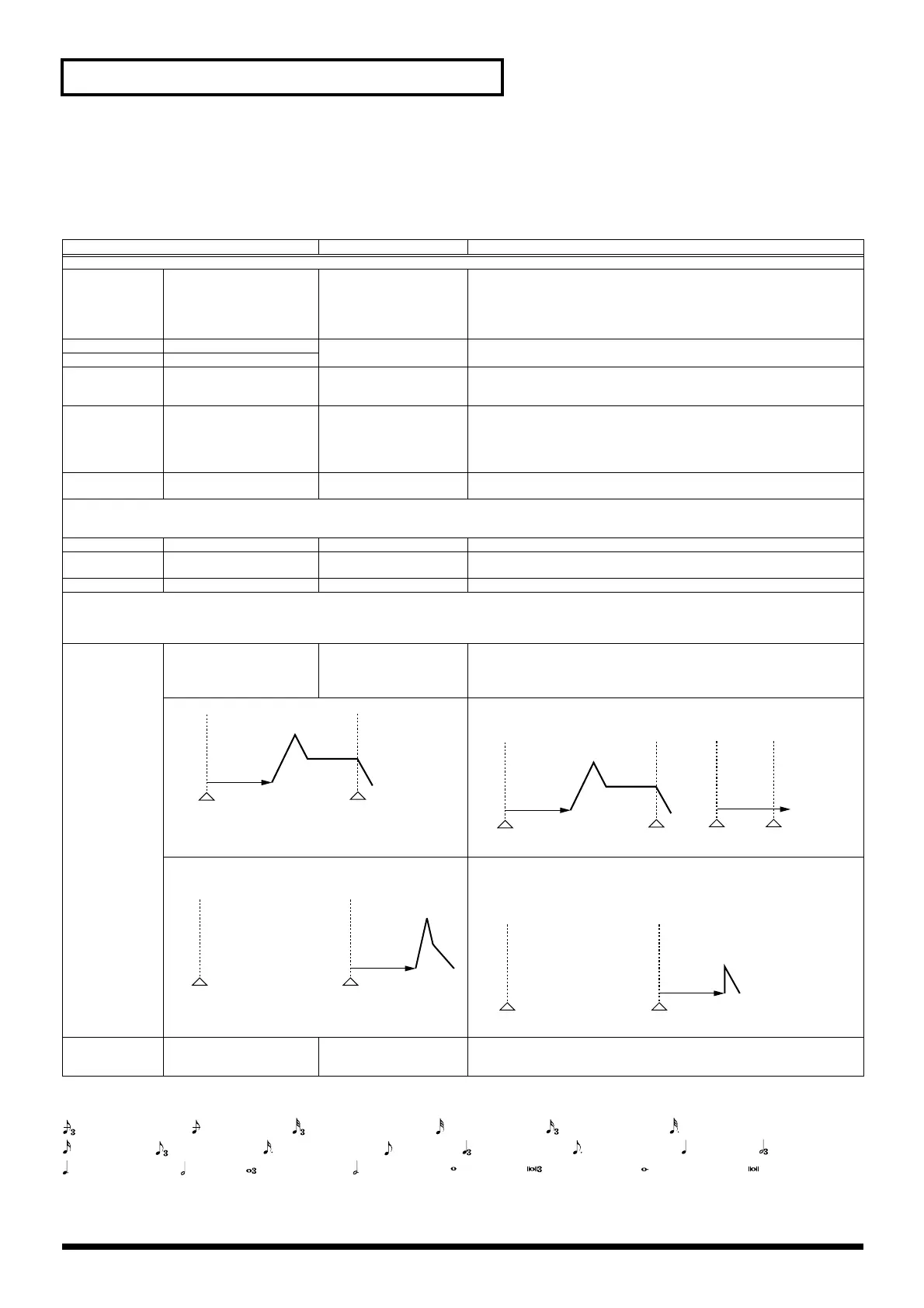44
Chapter 1 Creating a Patch
Changing a Waveform (WAVE)
This set of parameters allows you to select the PCM waveform that serves as the basis for the currently selected Tone, apply effects to the
waveform, and control its pitch.
*1:
fig.notelist.e
Parameter
Value Description
WAVE
Group
Wave Group INT, XP-A, XP-B Chooses the desired waveform’s group.
INT:
Internal
XP-A, B:
Wave Expansion Boards A, B
* It’s not possible to select XP-A, B unless a wave expansion board is inserted
into the corresponding slot.
L Wave Number Left 0001–1083 Chooses the desired waveform. You can choose a separate waveform for the
XV-5050’s left and right channels.
R Wave Number Right
Gain Wave Gain -6, 0, +6, +12 dB Specifies the gain (or amplitude) of the waveform. An increase of 6 dB doubles
the waveform’s gain. If you intend to use the Booster to distort the waveform’s
sound, set this parameter to its highest value.
Switch TMT Tone Switch OFF, ON Determines whether or not the Tone will be heard in the Patch. In order to make
best use of the available number of simultaneous voices, unused Tones should
be turned off.
* When TONE SW [1]–[4] are turned on or off, this setting is automatically
changed.
Tempo Sync Wave Tempo Sync OFF, ON Determines whether the waveform is synchronized (ON) or not synchronized
(OFF) to the Patch’s tempo.
FXM
FXM (Frequency Cross Modulation) uses a specified waveform to apply frequency modulation to the currently selected waveform, creating complex overtones. This
can be useful when creating wilder sounds or sound effects.
FXM Switch Wave FXM Switch OFF, ON Sets whether FXM will be used (ON) or not (OFF).
FXM Color Wave FXM Color 1–4 Specifies how FXM will perform its frequency modulation. Higher settings re-
sult in a grainier sound, while lower settings result in a more metallic sound.
FXM Depth Wave FXM Depth 0–16 Specifies the depth of the modulation produced by FXM.
Tone Delay
This produces a time delay between the moment a key is pressed (or released) and the moment the Tone actually begins to sound. Since you can adjust the timing of
each Tone in a Patch, you can create effects in which pressing a single key produces two or more sounds occurring at different times. If you don’t wish to use Tone
Delay, set Tone Dly to NORMAL and Tone Delay Time to 0.
Tone Dly Tone Delay Mode NORMAL, HOLD,
KEY-OFF-NOR,
KEY-OFF-DCY
Sets the manner in which the Tone sounds.
* If you’ve selected a Wave that is a decay-type sound (i.e., a sound that fades
away naturally even if the key is not released), selecting KEY-OFF-NOR or
KEY-OFF-DCY may result in no sound being heard.
NORMAL:
The Tone sounds after the specified Delay Time.
HOLD:
The Tone will only sound if the key is held for longer than the specified
Delay Time. If the key is released before the Delay Time has elapsed, the Tone
will not sound.
KEY-OFF-NOR:
The Tone doesn’t sound while the key is
being pressed, but sounds after the specified Delay Time
when the key is released.
KEY-OFF-DCY:
The Tone doesn’t sound while the key is being pressed, but
sounds after the specified Delay Time when the key is released. However, for
this setting—unlike KEY-OFF-NOR—the TVA envelope of the Tone begins
when the key is first pressed. As a result, in most cases, only the decay portion
of the sound is heard.
Tone Delay Time 0–127, note *1 Specifies the time after which the Tone sounds when using Tone Delay. When
the Struct Type parameter has a setting of 2–10, the outputs of Tones 1 (3) and
2 (4) are combined with Tone 2 (4). Tone 1 (or 3) settings are ignored.
release key
Delay Time
press key
release key
Delay Time
Tone does
not sound
press key
release key press key
Delay
Time
release key
Delay
Time
press key
release key
Delay
Time
press key
(Double note)(Dotted whole note),(Dotted half note),
(Dotted thirty-second note),
(Whole note), (Double-note triplet),
(Sixteenth-note triplet),(Thirty-second note),(Sixty-fourth-note triplet), (Sixty-fourth note), (Thirty-second-note triplet),
(Dotted eighth note),(Quarter-note triplet),(Eighth note), (Half-note triplet),(Quarter note),
(Dotted quarter note), (Whole-note triplet),(Half note),
(Sixteenth note),
(Eighth-note triplet), (Dotted sixteenth note),
XV-5050_e.book 44 ページ 2003年6月27日 金曜日 午後3時14分
